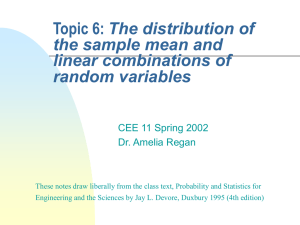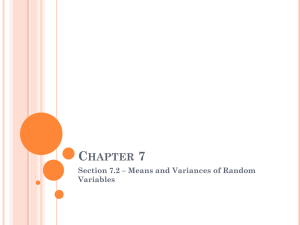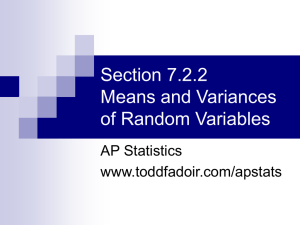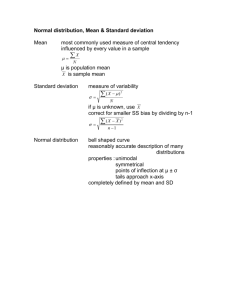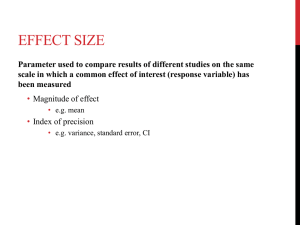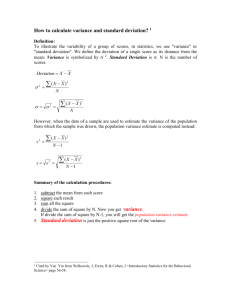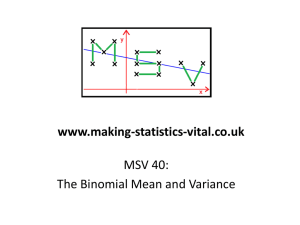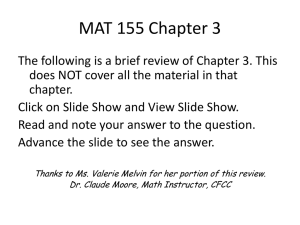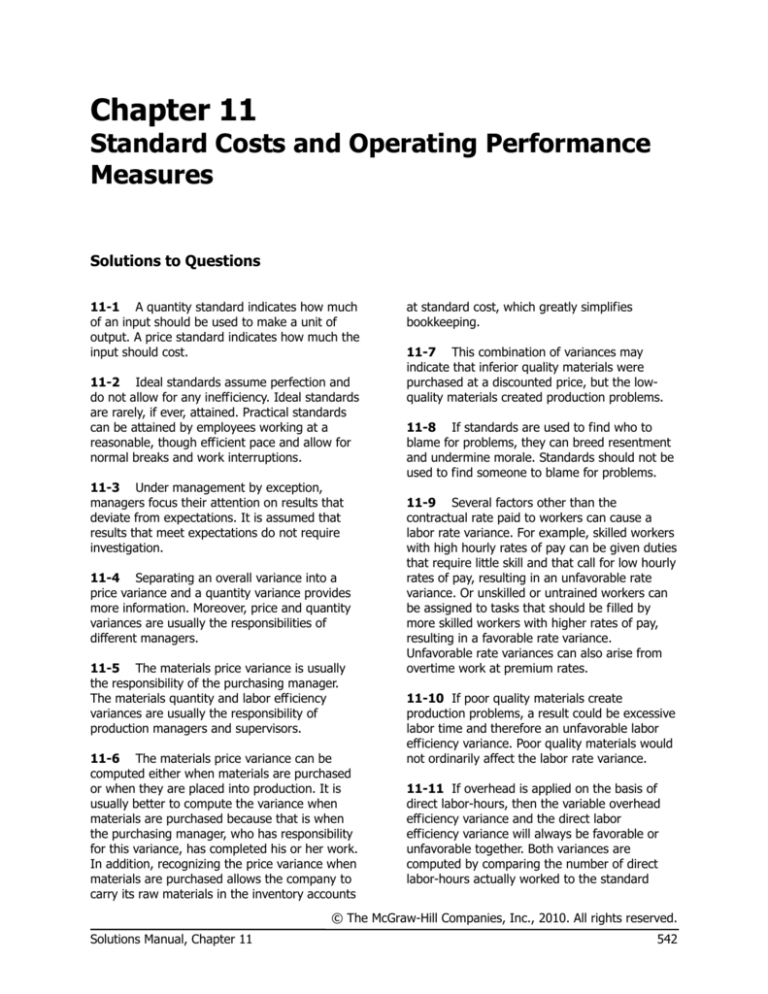
Chapter 11
Standard Costs and Operating Performance
Measures
Solutions to Questions
11-1 A quantity standard indicates how much
of an input should be used to make a unit of
output. A price standard indicates how much the
input should cost.
11-2 Ideal standards assume perfection and
do not allow for any inefficiency. Ideal standards
are rarely, if ever, attained. Practical standards
can be attained by employees working at a
reasonable, though efficient pace and allow for
normal breaks and work interruptions.
11-3 Under management by exception,
managers focus their attention on results that
deviate from expectations. It is assumed that
results that meet expectations do not require
investigation.
11-4 Separating an overall variance into a
price variance and a quantity variance provides
more information. Moreover, price and quantity
variances are usually the responsibilities of
different managers.
11-5 The materials price variance is usually
the responsibility of the purchasing manager.
The materials quantity and labor efficiency
variances are usually the responsibility of
production managers and supervisors.
11-6 The materials price variance can be
computed either when materials are purchased
or when they are placed into production. It is
usually better to compute the variance when
materials are purchased because that is when
the purchasing manager, who has responsibility
for this variance, has completed his or her work.
In addition, recognizing the price variance when
materials are purchased allows the company to
carry its raw materials in the inventory accounts
at standard cost, which greatly simplifies
bookkeeping.
11-7 This combination of variances may
indicate that inferior quality materials were
purchased at a discounted price, but the lowquality materials created production problems.
11-8 If standards are used to find who to
blame for problems, they can breed resentment
and undermine morale. Standards should not be
used to find someone to blame for problems.
11-9 Several factors other than the
contractual rate paid to workers can cause a
labor rate variance. For example, skilled workers
with high hourly rates of pay can be given duties
that require little skill and that call for low hourly
rates of pay, resulting in an unfavorable rate
variance. Or unskilled or untrained workers can
be assigned to tasks that should be filled by
more skilled workers with higher rates of pay,
resulting in a favorable rate variance.
Unfavorable rate variances can also arise from
overtime work at premium rates.
11-10 If poor quality materials create
production problems, a result could be excessive
labor time and therefore an unfavorable labor
efficiency variance. Poor quality materials would
not ordinarily affect the labor rate variance.
11-11 If overhead is applied on the basis of
direct labor-hours, then the variable overhead
efficiency variance and the direct labor
efficiency variance will always be favorable or
unfavorable together. Both variances are
computed by comparing the number of direct
labor-hours actually worked to the standard
© The McGraw-Hill Companies, Inc., 2010. All rights reserved.
Solutions Manual, Chapter 11
542
hours allowed. That is, in each case the formula
is:
Efficiency Variance = SR(AH – SH)
Only the “SR” part of the formula, the standard
rate, differs between the two variances.
11-12 A statistical control chart is a graphical
aid that helps identify variances that should be
investigated. Upper and lower limits are set on
the control chart. Any variances falling between
those limits are considered to be normal. Any
variances falling outside of those limits are
considered abnormal and are investigated.
11-13 If labor is a fixed cost and standards are
tight, then the only way to generate favorable
labor efficiency variances is for every
workstation to produce at capacity. However, the
output of the entire system is limited by the
capacity of the bottleneck. If workstations
before the bottleneck in the production process
produce at capacity, the bottleneck will be
unable to process all of the work in process. In
general, if every workstation is attempting to
produce at capacity, then work in process
inventory will build up in front of the
workstations with the least capacity.
11-14 The difference between delivery cycle
time and throughput time is the waiting period
between when an order is received and when
production on the order is started. Throughput
time is made up of process time, inspection
time, move time, and queue time. These four
elements can be classified into value-added time
(process time) and non-value-added time
(inspection time, move time, and queue time).
11-15 An MCE of less than 1 means that the
production process includes non-value-added
time. An MCE of 0.40, for example, means that
40% of throughput time consists of actual
processing, and that the other 60% consists of
moving, inspection, and other non-value-added
activities.
© The McGraw-Hill Companies, Inc., 2010
Solutions Manual, Chapter 11
543
Exercise 11-1 (20 minutes)
1. Cost per 15-gallon container ................................
Less 2% cash discount ........................................
Net cost .............................................................
Add shipping cost per container ($130 ÷ 100) ......
Total cost per 15-gallon container (a) ...................
Number of quarts per container
(15 gallons × 4 quarts per gallon) (b) ................
Standard cost per quart purchased (a) ÷ (b) ........
2. Content per bill of materials .............................
Add allowance for evaporation and spillage
(7.6 quarts ÷ 0.95 = 8.0 quarts;
8.0 quarts – 7.6 quarts = 0.4 quarts) ............
Total ..............................................................
Add allowance for rejected units
(8.0 quarts ÷ 40 bottles) ..............................
Standard quantity per salable bottle of solvent..
3.
Item
Echol
Standard
Quantity
8.2 quarts
Standard Price
$1.90 per quart
$115.00
2.30
112.70
1.30
$114.00
60
$1.90
7.6 quarts
0.4 quarts
8.0 quarts
0.2 quarts
8.2 quarts
Standard Cost
per Bottle
$15.58
© The McGraw-Hill Companies, Inc., 2010
Solutions Manual, Chapter 11
544
Exercise 11-5 (20 minutes)
1. Throughput time = Process time + Inspection time + Move time +
Queue time
= 2.7 days + 0.3 days + 1.0 days + 5.0 days
= 9.0 days
2. Only process time is value-added time; therefore the
manufacturing cycle efficiency (MCE) is:
MCE =
Value-added time 2.7 days
=
= 0.30
Throughput time
9.0 days
3. If the MCE is 30%, then 30% of the throughput time was spent in
value-added activities. Consequently, the other 70% of the
throughput time was spent in non-value-added activities.
4.
Delivery cycle time = Wait time + Throughput time
= 14.0 days + 9.0 days
= 23.0 days
5. If all queue time is eliminated, then the throughput time drops to
only 4 days (2.7 + 0.3 + 1.0). The MCE becomes:
MCE =
Value-added time 2.7 days
=
= 0.675
Throughput time
4.0 days
Thus, the MCE increases to 67.5%. This exercise shows quite
dramatically how lean production can improve the efficiency of
operations and reduce throughput time.
© The McGraw-Hill Companies, Inc., 2010
Solutions Manual, Chapter 11
545
Exercise 11-6 (20 minutes)
1. The standard price of a kilogram of white chocolate is determined
as follows:
Purchase price, finest grade white chocolate ........................
Less purchase discount, 8% of the purchase price of £7.50 ..
Shipping cost from the supplier in Belgium ..........................
Receiving and handling cost ...............................................
Standard price per kilogram of white chocolate ....................
£7.50
(0.60)
0.30
0.04
£7.24
2. The standard quantity, in kilograms, of white chocolate in a dozen
truffles is computed as follows:
Material requirements ............................
Allowance for waste ...............................
Allowance for rejects ..............................
Standard quantity of white chocolate ......
0.70
0.03
0.02
0.75
3. The standard cost of the white chocolate in a dozen truffles is
determined as follows:
Standard quantity of white chocolate (a) ...... 0.75 kilogram
Standard price of white chocolate (b) ........... £7.24 per kilogram
Standard cost of white chocolate (a) × (b) ... £5.43
© The McGraw-Hill Companies, Inc., 2010
Solutions Manual, Chapter 11
546
Exercise 11-7 (30 minutes)
1. a. Notice in the solution below that the materials price variance is
computed on the entire amount of materials purchased,
whereas the materials quantity variance is computed only on
the amount of materials used in production.
Actual Quantity
Standard Quantity
of Input, at
Actual Quantity of
Allowed for Output, at
Actual Price
Input, at Standard Price
Standard Price
(AQ × AP)
(AQ × SP)
(SQ × SP)
25,000 microns ×
25,000 microns ×
18,000 microns* ×
$0.48 per micron
$0.50 per micron
$0.50 per micron
= $12,000
= $12,500
= $9,000
Price Variance,
$500 F
20,000 microns × $0.50 per micron
= $10,000
Quantity Variance,
$1,000 U
*3,000 toys × 6 microns per toy = 18,000 microns
Alternatively, the variances can be computed using the formulas:
F
U
Materials price variance = AQ (AP – SP)
25,000 microns ($0.48 per micron – $0.50 per micron) = $500
Materials quantity variance = SP (AQ – SQ)
$0.50 per micron (20,000 microns – 18,000 microns) = $1,000
© The McGraw-Hill Companies, Inc., 2010
Solutions Manual, Chapter 11
547
Exercise 11-7 (continued)
b. Direct labor variances:
Actual Hours of
Input, at the
Actual Rate
(AH × AR)
Standard Hours Allowed
Actual Hours of Input,
for Output, at the
at the Standard Rate
Standard Rate
(AH × SR)
(SH × SR)
4,000 hours ×
3,900 hours* ×
$8.00 per hour
$8.00 per hour
= $32,000
= $31,200
$36,000
Rate Variance,
Efficiency Variance,
$4,000 U
$800 U
Total Variance,
$4,800 U
*3,000 toys × 1.3 hours per toy = 3,900 hours
Alternatively, the variances can be computed using the formulas:
Labor rate variance = AH (AR – SR)
4,000 hours ($9.00 per hour* – $8.00 per hour) = $4,000 U
*$36,000 ÷ 4,000 hours = $9.00 per hour
Labor efficiency variance = SR (AH – SH)
$8.00 per hour (4,000 hours – 3,900 hours) = $800 U
© The McGraw-Hill Companies, Inc., 2010
Solutions Manual, Chapter 11
548
Exercise 11-7 (continued)
2. A variance usually has many possible explanations. In particular,
we should always keep in mind that the standards themselves may
be incorrect. Some of the other possible explanations for the
variances observed at Dawson Toys appear below:
Materials Price Variance Since this variance is favorable, the actual
price paid per unit for the material was less than the standard price.
This could occur for a variety of reasons including the purchase of a
lower grade material at a discount, buying in an unusually large
quantity to take advantage of quantity discounts, a change in the
market price of the material, or particularly sharp bargaining by the
purchasing department.
Materials Quantity Variance Since this variance is unfavorable,
more materials were used to produce the actual output than were
called for by the standard. This could also occur for a variety of
reasons. Some of the possibilities include poorly trained or
supervised workers, improperly adjusted machines, and defective
materials.
Labor Rate Variance Since this variance is unfavorable, the actual
average wage rate was higher than the standard wage rate. Some
of the possible explanations include an increase in wages that has
not been reflected in the standards, unanticipated overtime, and a
shift toward more highly paid workers.
Labor Efficiency Variance Since this variance is unfavorable, the
actual number of labor hours was greater than the standard labor
hours allowed for the actual output. As with the other variances,
this variance could have been caused by any of a number of factors.
Some of the possible explanations include poor supervision, poorly
trained workers, low-quality materials requiring more labor time to
process, and machine breakdowns. In addition, if the direct labor
force is essentially fixed, an unfavorable labor efficiency variance
could be caused by a reduction in output due to decreased demand
for the company’s products.
It is worth noting that all of these variances could have been caused
by the purchase of low quality materials at a cut-rate price.
© The McGraw-Hill Companies, Inc., 2010
Solutions Manual, Chapter 11
549
Exercise 11-10 (30 minutes)
1. Number of units manufactured ............................
Standard labor time per unit
(18 minutes ÷ 60 minutes per hour) ..................
Total standard hours of labor time allowed ...........
Standard direct labor rate per hour ......................
Total standard direct labor cost ............................
× 0.3
6,000
× $12
$72,000
Actual direct labor cost ........................................
Standard direct labor cost ....................................
Total variance—unfavorable .................................
$73,600
72,000
$ 1,600
2.
20,000
Actual Hours of
Input, at the
Actual Rate
(AH × AR)
Standard Hours Allowed
Actual Hours of Input,
for Output, at the
at the Standard Rate
Standard Rate
(AH × SR)
(SH × SR)
5,750 hours ×
6,000 hours* ×
$12.00 per hour
$12.00 per hour
= $69,000
= $72,000
$73,600
Rate Variance,
Efficiency Variance,
$4,600 U
$3,000 F
Total Variance,
$1,600 U
*20,000 units × 0.3 hours per unit = 6,000 hours
Alternatively, the variances can be computed using the formulas:
Labor rate variance = AH (AR – SR)
5,750 hours ($12.80 per hour* – $12.00 per hour) = $4,600 U
*$73,600 ÷ 5,750 hours = $12.80 per hour
Labor efficiency variance = SR (AH – SH)
$12.00 per hour (5,750 hours – 6,000 hours) = $3,000 F
© The McGraw-Hill Companies, Inc., 2010
Solutions Manual, Chapter 11
550
Exercise 11-10 (continued)
3.
Actual Hours of
Input, at the
Actual Rate
(AH × AR)
Standard Hours
Actual Hours of Input, Allowed for Output, at
at the Standard Rate
the Standard Rate
(AH × SR)
(SH × SR)
5,750 hours ×
6,000 hours ×
$4.00 per hour
$4.00 per hour
= $23,000
= $24,000
$21,850
Rate Variance,
Efficiency Variance,
$1,150 F
$1,000 F
Total Variance,
$2,150 F
Alternatively, the variances can be computed using the formulas:
Variable overhead rate variance = AH (AR – SR)
5,750 hours ($3.80 per hour* – $4.00 per hour) = $1,150 F
*$21,850 ÷ 5,750 hours = $3.80 per hour
Variable overhead efficiency variance = SR (AH – SH)
$4.00 per hour (5,750 hours – 6,000 hours) = $1,000 F
© The McGraw-Hill Companies, Inc., 2010
Solutions Manual, Chapter 11
551
Exercise 11-11 (20 minutes)
1. If the total variance is $93 unfavorable, and the rate variance is
$87 favorable, then the efficiency variance must be $180
unfavorable, because the rate and efficiency variances taken
together always equal the total variance. Knowing that the
efficiency variance is $180 unfavorable, one approach to the
solution would be:
Efficiency variance = SR (AH – SH)
$9.00 per hour (AH – 125 hours*) = $180 U
$9.00 per hour × AH – $1,125 = $180**
$9.00 per hour × AH = $1,305
AH = $1,305 ÷ $9.00 per hour
AH = 145 hours
*50 jobs × 2.5 hours per job = 125 hours
**When used with the formula, unfavorable variances are positive and
favorable variances are negative.
2.
Rate variance = AH (AR – SR)
145 hours (AR – $9.00 per hour) = $87 F
145 hours × AR – $1,305 = –$87*
145 hours × AR = $1,218
AR = $1,218 ÷ 145 hours
AR = $8.40 per hour
*When used with the formula, unfavorable variances are positive and
favorable variances are negative.
© The McGraw-Hill Companies, Inc., 2010
Solutions Manual, Chapter 11
552
Exercise 11-11 (continued)
An alternative approach would be to work from known to unknown
data in the columnar model for variance analysis:
Standard Hours
Actual Hours of Input,
Actual Hours of Input, Allowed for Output, at
at the Actual Rate
at the Standard Rate
the Standard Rate
(AH × AR)
(AH × SR)
(SH × SR)
145 hours ×
145 hours ×
125 hours§ ×
$8.40 per hour
$9.00 per hour*
$9.00 per hour*
= $1,218
= $1,305
= $1,125
Rate Variance,
Efficiency Variance,
$87 F*
$180 U
Total Variance,
$93 U*
§
50 tune-ups* × 2.5 hours per tune-up* = 125 hours
*Given
© The McGraw-Hill Companies, Inc., 2010
Solutions Manual, Chapter 11
553
Problem 11-13 (30 minutes)
1. a., b., and c.
Throughput time—days:
Process time (x) ................................
Inspection time .................................
Move time .........................................
Queue time .......................................
Total throughput time (y) ...................
1
2.1
0.6
0.4
4.3
7.4
Month
2
3
2.0
0.7
0.3
5.0
8.0
4
1.9
0.7
0.4
5.8
8.8
1.8
0.6
0.4
6.7
9.5
Manufacturing cycle efficiency (MCE):
Process time (x) ÷
Throughput time (y) ........................ 28.4% 25.0% 21.6% 18.9%
Delivery cycle time—days:
Wait time from order to start of
production ...................................... 16.0
Throughput time ...............................
7.4
Total delivery cycle time ..................... 23.4
17.5
8.0
25.5
19.0
8.8
27.8
20.5
9.5
30.0
2. All of the performance measures display unfavorable trends.
Throughput time per unit is increasing—largely because of an
increase in queue time. Manufacturing cycle efficiency is declining
and delivery cycle time is increasing. In addition, the percentage
of on-time deliveries has dropped.
© The McGraw-Hill Companies, Inc., 2010
Solutions Manual, Chapter 11
554
Problem 11-13 (continued)
3. a. and b.
Month
Throughput time—days:
Process time (x) .............................................
Inspection time ..............................................
Move time ......................................................
Queue time ....................................................
Total throughput time (y) ................................
Manufacturing cycle efficiency (MCE):
Process time (x) ÷ Throughput time (y) ...........
5
1.8
0.6
0.4
0.0
2.8
64.3%
6
1.8
0.0
0.4
0.0
2.2
81.8%
As a company reduces non-value-added activities, the
manufacturing cycle efficiency increases rapidly. The goal, of
course, is to have an efficiency of 100%. This will be achieved
when all non-value-added activities have been eliminated and
process time is equal to throughput time.
© The McGraw-Hill Companies, Inc., 2010
Solutions Manual, Chapter 11
555
Problem 11-15 (45 minutes)
1. The standard quantity of plates allowed for tests performed during
the month would be:
Blood tests...................................
Smears ........................................
Total ............................................
Plates per test ..............................
Standard quantity allowed ............
1,800
2,400
4,200
× 2
8,400
The variance analysis for plates would be:
Actual Quantity
Standard Quantity
Actual Quantity of
of Input, at
Allowed for Output,
Input, at Actual Price
Standard Price
at Standard Price
(AQ × AP)
(AQ × SP)
(SQ × SP)
12,000 plates ×
8,400 plates ×
$2.50 per plate
$2.50 per plate
= $30,000
= $21,000
$28,200
Price Variance,
$1,800 F
10,500 plates × $2.50 per plate = $26,250
Quantity Variance,
$5,250 U
Alternatively, the variances can be computed using the formulas:
Materials price variance = AQ (AP – SP)
12,000 plates ($2.35 per plate* – $2.50 per plate) = $1,800 F
*$28,200 ÷ 12,000 plates = $2.35 per plate.
Materials quantity variance = SP (AQ – SQ)
$2.50 per plate (10,500 plates – 8,400 plates) = $5,250 U
© The McGraw-Hill Companies, Inc., 2010
Solutions Manual, Chapter 11
556
Problem 11-15 (continued)
Note that all of the price variance is due to the hospital’s 6%
quantity discount. Also note that the $5,250 quantity variance for
the month is equal to 25% of the standard cost allowed for plates.
2. a. The standard hours allowed for tests performed during the
month would be:
Blood tests: 0.3 hour per test × 1,800 tests ........... 540 hours
Smears: 0.15 hour per test × 2,400 tests .............. 360 hours
Total standard hours allowed ................................ 900 hours
The variance analysis would be:
Actual Hours of
Input, at the
Actual Rate
(AH × AR)
Standard Hours
Actual Hours of Input, Allowed for Output, at
at the Standard Rate
the Standard Rate
(AH × SR)
(SH × SR)
1,150 hours ×
900 hours ×
$14.00 per hour
$14.00 per hour
= $16,100
= $12,600
$13,800
Rate Variance,
Efficiency Variance,
$2,300 F
$3,500 U
Total Variance,
$1,200 U
Alternatively, the variances can be computed using the formulas:
Labor rate variance = AH (AR – SR)
1,150 hours ($12.00 per hour* – $14.00 per hour) = $2,300 F
*$13,800 ÷ 1,150 hours = $12.00 per hour
Labor efficiency variance = SR (AH – SH)
$14.00 per hour (1,150 hours – 900 hours) = $3,500 U
© The McGraw-Hill Companies, Inc., 2010
Solutions Manual, Chapter 11
557
Problem 11-15 (continued)
b. The policy probably should not be continued. Although the
hospital is saving $2 per hour by employing more assistants
than senior technicians, this savings is more than offset by
other factors. Too much time is being taken in performing lab
tests, as indicated by the large unfavorable labor efficiency
variance. And, it seems likely that most (or all) of the hospital’s
unfavorable quantity variance for plates is traceable to
inadequate supervision of assistants in the lab.
3. The variable overhead variances follow:
Actual Hours of
Input, at the
Actual Rate
(AH × AR)
Standard Hours
Actual Hours of Input,
Allowed for Output,
at the Standard Rate
at the Standard Rate
(AH × SR)
(SH × SR)
1,150 hours ×
900 hours ×
$6.00 per hour
$6.00 per hour
= $6,900
= $5,400
$7,820
Rate Variance,
Efficiency Variance,
$920 U
$1,500 U
Total Variance,
$2,420 U
Alternatively, the variances can be computed using the formulas:
Variable overhead rate variance = AH (AR – SR)
1,150 hours ($6.80 per hour* – $6.00 per hour) = $920 U
*$7,820 ÷ 1,150 hours = $6.80 per hour
Variable overhead efficiency variance = SR (AH – SH)
$6.00 per hour (1,150 hours – 900 hours) = $1,500 U
Yes, the two variances are closely related. Both are computed by
comparing actual labor time to the standard hours allowed for the
output of the period. Thus, if the labor efficiency variance is
favorable (or unfavorable), then the variable overhead efficiency
variance will also be favorable (or unfavorable).
© The McGraw-Hill Companies, Inc., 2010
Solutions Manual, Chapter 11
558
Problem 11-16 (30 minutes)
1. Salex quantity standard:
Required per 10-liter batch (9.6 liters ÷ 0.8) ........
Loss from rejected batches (1/5 × 12 liters) .........
Total quantity per good batch ..............................
12.0 liters
2.4 liters
14.4 liters
Nyclyn quantity standard:
Required per 10-liter batch (12 kilograms ÷ 0.8) ..
Loss from rejected batches (1/5 × 15 kilograms) ..
Total quantity per good batch ..............................
15.0 kilograms
3.0 kilograms
18.0 kilograms
Protet quantity standard:
Required per 10-liter batch..................................
Loss from rejected batches (1/5 × 5 kilograms)....
Total quantity per good batch ..............................
5.0 kilograms
1.0 kilograms
6.0 kilograms
2. Total minutes per 8-hour day .................................
Less rest breaks and cleanup .................................
Productive time each day .......................................
480 minutes
60 minutes
420 minutes
Productive time each day
420 minutes per day
=
Time required per batch
35 minutes per batch
= 12 batches per day
Time required per batch ........................................
Rest breaks and clean up time
(60 minutes ÷ 12 batches)..................................
Total ....................................................................
Loss from rejected batches (1/5 × 40 minutes).......
Total time per good batch ......................................
35 minutes
5
40
8
48
minutes
minutes
minutes
minutes
© The McGraw-Hill Companies, Inc., 2010
Solutions Manual, Chapter 11
559
Problem 11-16 (continued)
3. Standard cost card:
Salex .....................
Nyclyn ...................
Protet ....................
Labor time .............
Total standard
cost per
acceptable batch .
Standard
Quantity or
Time
14.4 liters
18.0 kilograms
6.0 kilograms
48 minutes,
or 0.8 hour
Standard Price
or Rate
$1.50 per liter
$2.80 per kilogram
$3.00 per kilogram
$9.00 per hour
Standard
Cost
$21.60
50.40
18.00
7.20
$97.20
© The McGraw-Hill Companies, Inc., 2010
Solutions Manual, Chapter 11
560
Problem 11-17 (30 minutes)
1. a., b., and c.
Month
Throughput time in days:
Process time ..................................
Inspection time ..............................
Move time .....................................
Queue time during production ........
Total throughput time.....................
Manufacturing cycle efficiency (MCE):
Process time ÷ Throughput time .....
Delivery cycle time in days:
Wait time to start of production ......
Throughput time ............................
Total delivery cycle time .................
1
2
3
4
2.1
0.8
0.3
2.8
6.0
2.0
0.7
0.4
4.4
7.5
1.9
0.7
0.4
6.0
9.0
1.8
0.7
0.5
7.0
10.0
35.0% 26.7% 21.1% 18.0%
9.0
6.0
15.0
11.5
7.5
19.0
12.0
9.0
21.0
14.0
10.0
24.0
2. a. Areas where the company is improving:
Quality control. The number of defects has decreased by over
50% in the last four months. Moreover, both warranty claims
and customer complaints are down sharply. In short, overall
quality appears to have significantly improved.
Material control. The purchase order lead time is only half of
what it was four months ago, which indicates that purchases
are arriving in less time. This trend may be a result of the
company’s move toward JIT purchasing.
Delivery performance. The process time has decreased from 2.1
days to 1.8 days over the last four months.
© The McGraw-Hill Companies, Inc., 2010
Solutions Manual, Chapter 11
561
Problem 11-17 (continued)
b. Areas of deterioration:
Material control. Scrap as a percentage of total cost has tripled
over the last four months.
Machine performance. Machine downtime has doubled over the
last four months. This may be a result of the greater setup
time, or it may just reflect efforts to get the new equipment
operating properly. Also note that use of the machines as a
percentage of availability is declining rapidly.
Delivery performance. All delivery performance measures are
moving in the wrong direction. Throughput time and delivery
cycle time are both increasing, and the manufacturing cycle
efficiency is decreasing.
3. a. and b.
Month
Throughput time in days:
Process time...........................................
Inspection time ......................................
Move time ..............................................
Queue time during production .................
Total throughput time .............................
Manufacturing cycle efficiency (MCE):
Process time ÷ Throughput time .............
5
6
1.8
0.7
0.5
0.0
3.0
1.8
0.0
0.5
0.0
2.3
60.0% 78.3%
As non-value-added activities are eliminated, the manufacturing
cycle efficiency improves. The goal, of course, is to have an
efficiency of 100%. This is achieved when all non-value-added
activities have been eliminated and process time equals
throughput time.
© The McGraw-Hill Companies, Inc., 2010
Solutions Manual, Chapter 11
562


